22 Types of Huskies
April 11, 2023 2023-08-18 8:01Huskies are beautiful, energetic and loving companions. Many families get them for their soft coat, cool eye colors, friendly nature and funny character.
When we use the word “Husky” we typically refer to the Siberian Husky. However, there are many different types of Huskies. Today we want to explore all Husky breeds.
Table of Contents
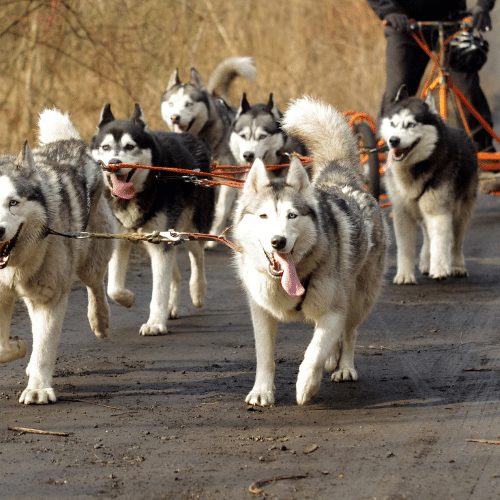
How many type of Huskies are there?
The only breed recognized by the American Kennel Club that is called Husky is the Siberian Husky. However, many other types of Northern breeds are colloquially referred to as “Husky”. There are 22 different types of Husky-like dogs. Let’s discover them all in detail!

Siberian Husky
This is the “original Husky”. Siberian Huskies were once bred to be sled dogs. They have phenomenal endurance and are true athletes. While Huskies are mostly known for performing in sled races, they actually worked for the US Army’s Arctic Search and Rescue Unit during World War II as well!
Siberian Huskies are medium-sized dogs that grow up to be about 35-55 pounds and 20-24 inches tall. They require extensive amounts of physical exercise and mental stimulation in order to not be destructive. Many owners are surprised by how much their Huskies shed. If acquiring a Husky, get ready for brushing him and providing physical activities daily.
Huskies are very friendly, outgoing and vocal dogs. As long as they are treated well, they are docile and unlikely to bite. They are not the best dog for first-time dog owners due to their extensive needs for stimulation and activity.
Alaskan Malamute
The Alaskan Malamute is the big cousin of the Siberian Husky. While looking very similar, these dogs are a lot larger. Males can reach up to 95 pounds in size and stand as tall as 26 inches.
Alaskan Malamutes are one of the oldest sled dog breeds. They descended directly from wolves and were creates as long as 2000-3000 years ago. Their name “Malamute” is derived from the tribe that originally created this breed: the Mahlemut.
Malamutes were used for any kind of task that came up: hunting game, towing supplies, guarding properties, and providing warmth to their owners. They were (and are) very “wolf-like” dogs. It is said that the Mahlemuts would tie females in season up to trees in the forest so that wild wolves would mate with them, increasing the wolf percentage in their blood.
In 1935 the American Kennel Club accepted the Malamute as a registered breed. Nowadays, they are rarely used in their original functions anymore. They do retrain a strong independent character from their wolf heritage. This trait is passed on when this dog is crossed with other breeds as well, such as in creating the King Shepherd.
This type of Husky is not a good choice for first-time dog owners. You need plenty of space and experience to raise and care for a Malamute properly.
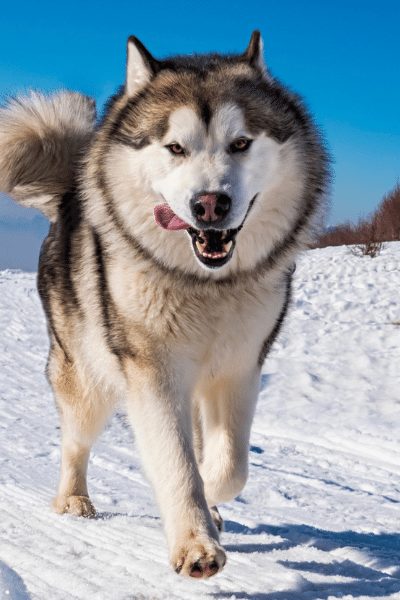
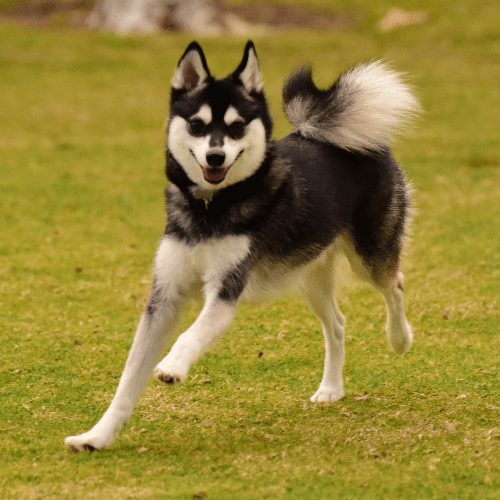
Alaskan Klee Kai
The Alaskan Malamute is a giant Husky, the Klee Klai is a tiny type of Husky!
Similar to many other Husky types, the origin of this breed is in Alaska. Klee Kais once were larger than they are nowadays and assisted their owners in many areas. Pulling sleds, guarding the property and tracking game were just some of their tasks.
In the 1970s, a breeding program in the USA started to selectively pair smaller and lighter Husky-type dogs. The goal was to create a companion dog that looks like a Husky, but is little and has more manageable exercise needs.
The Alaskan Klee Kai indeed is a small dog – weighing only 15-22 pounds and standing at 15-17 inches tall. These dogs are great dogs for owners who want to own a Husky-type dog but are unsure if they can keep up with the exercise needs of a Siberian Husky.
Though tiny, these dogs are athletic and smart. They excel at dog sports such as agility or nosework.
Chinook
The Chinook may not look like other types of Huskies, but he is a sled dog as well! Most other dogs on our list share the characteristic prick ears, curled tail, plush coat and facial markings. The Chinook however may remind you more of a Labrador than a Husky!
They are large dogs, standing 22-26 inches tall and weighing 55-90 pounds. While recognized by the AKC in 2013, this breed is extremely rare – it currently has rank 190 out of the 197 breeds registered with the American Kennel Club.
Chinooks were bred in the late 1900s by crossing Mastiff-type dogs with Huskies. Their place of origin? New Hampshire! They are the official state dog of this US state.
Chinooks are very friendly dogs. They usually get along well with other dogs and humans alike. They are independent thinkers and require a skilled and experienced trainer.
Chinooks will – like all types of Husky – require extensive exercise in order to not be destructive or develop behavioral problems.
American Eskimo Dog (Standard)
Another small dog on our list, the American Eskimo is the most popular type of Husky companion dog.
Not to be confused with the Klee Klai, American Eskimos are always pure white and do not have any black markings. They also are a bit larger – the Standard-sized dogs weigh 18-35 pounds and stand at 15-20 inches tall.
American Eskimos originated in Germany and became popular as smart and friendly companion dogs all over the world. They are highly intelligent and attach themselves closely to their person.
For dog owners who are looking for an even smaller Husky-type dog, there is also the Miniature and Toy version of the American Eskimo:
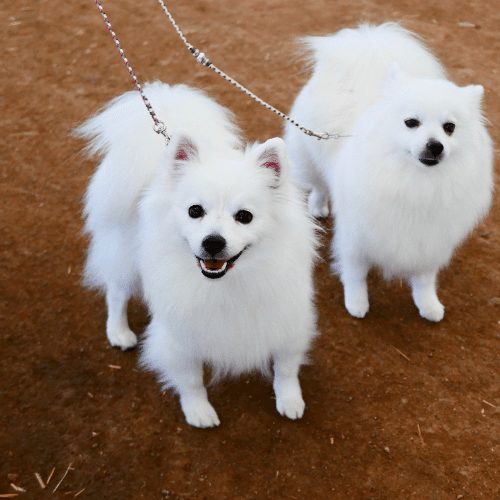

American Eskimo Dog (Mini & Toy)
As with many dog breeds (such as also Poodles, Goldendoodles or Schnauzers), the American Eskimo comes in different size categories.
After the original American Eskimo was developed, some breeders kept pairing smaller and smaller dogs. The result was the Miniature and the Toy American Eskimo Dog. These teeny tiny Huskies can be as small as 12-15 inches (Mini) or 9-12 inches (Toy).
They are very friendly dogs with lower exercise needs than most other kinds of Husky. This makes them especially popular as dogs for apartment dwellers and big cities.
Mini and Toy American Eskimos are very intelligent and love to learn tricks. They will happily train with you every day. Due to their small size, they shed much less than full-size Huskies.
White Husky
The white Siberian Husky is the rarest color of Husky. While most light-colored Huskies have some brown or black markings, a true white Husky has no color besides white.
They nearly always have blue eyes. These dogs are not albinos. Other than their highly unusual coloring, their traits are like any other Husky.
Some owners acquire white Huskies because of their rarity. Do not do this! A white Husky is not “just a pretty dog” – he is a working dog that will require exercise, training and enrichment, every single day.
Light-colored dogs tend to shed a bit more than dark-colored ones, so with a white Husky, get ready for a lot of brushing and vacuuming.
These dogs can be quite tricky to find and may cost considerable more than Huskies with regular markings.
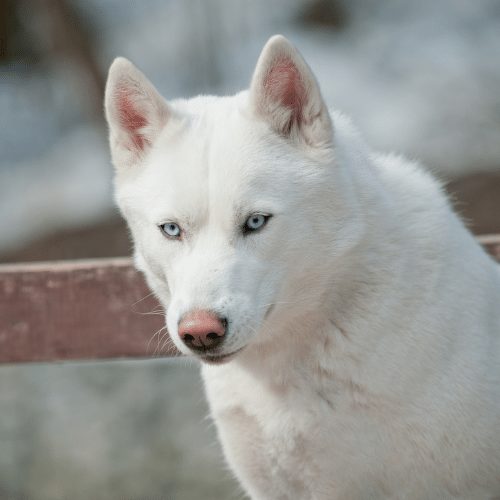
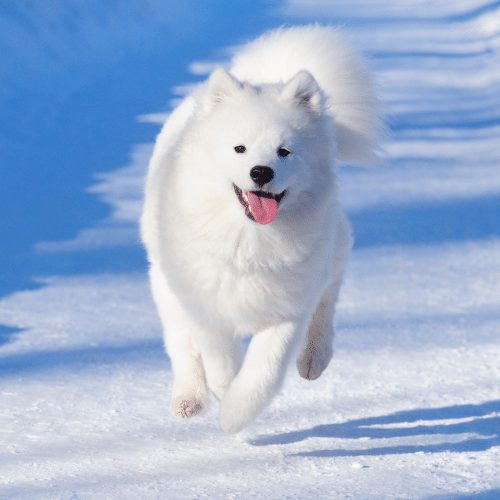
Samoyed
The Samoyed may look like a white Husky, but he is a different breed altogether. These medium-sized dogs are about 21 inches tall and weight 34-55 pounds.
They originally come from Asia and Siberia. The ancestors of the modern-day Samoyed were once used to hunt reindeer. Later on, they served as a herding dog for domesticated herds of reindeer and as sled dogs.
Like all types of Huskies, Samoyeds are very friendly and happy dogs. Due to their extremely thick coat they do not do well in hot climates and cannot be left outside in the summer.
Samoyeds usually have black noses and brown eyes – one way to distinguish them from white Siberian Huskies. While blue eyes may occur occasionally, they are not allowed in the show ring.
Agouti Husky
The Agouti Husky is essentially the opposite of the White Husky – exceptionally dark-colored. These dogs have a wolf-like appearance. This coloring is rare in show lines and mostly found in racing sled dog lines.
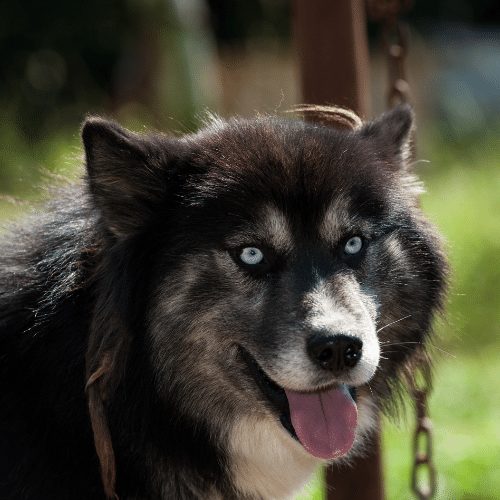
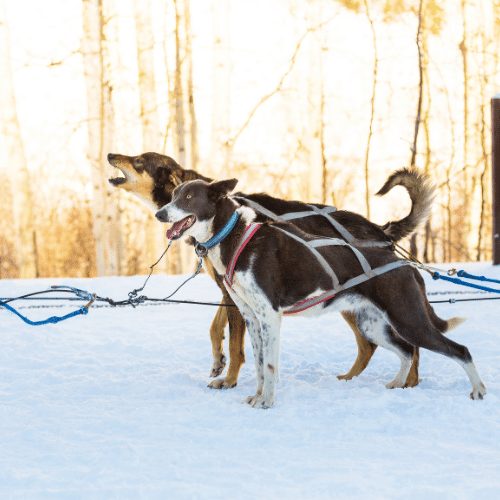
Alaskan Husky
The Alaskan Husky is the brother of the Siberian Husky. While currently not recognized by the AKC, this “unofficial” breed is a mix of several working dogs.
Siberian Huskies are crossed with high-endurance and high-speed breeds in order to produce superior sled dogs. Breeds used to create the Alaskan Huskies are for example:
- Greyhounds
- German Shorthair Pointers
- Alaskan Malamute
Alaskan Huskies are not good pet dogs. They are fantastic companions if you are looking for a dog to go running or backpacking with.
In families who do not participate in active hobbies though, these dogs become highly destructive and problematic. They are true athletes and will require an athlete’s exercise regime!
Sakhalin Husky
The Sakhalin Husky (also called Karafuto Ken) is a nearly extinct breed of sled dog from Japan. They were purpose-bred dogs first and foremost and are currently not recognized by any major kennel club.
The Sakhalin Husky became famous when an expedition of Japanese researchers had to be evacuated from Antartica in 1958. They had a team of 15 sled dogs with them. Believing that the dogs would be rescued soon after, they left them to their own devices, chained up with some food and water. However, after a big storm rolled in, nobody ever arrived to take care of the dogs.
They were believed to be deceased, but one year later new researches arrived and found that two of the Sakhalin Huskies had miraculously survived.
Only a few breeders of this breed remain in Japan, and the exact number of dogs of this kind of Husky is unknown.
You are unlikely to ever encounter a Sakhalin Husky!
Labrador Husky
The name of this type of Husky is misleading. Many believe that the Labrador Husky is a cross between a Siberian Husky and a Labrador Retriever. In fact, the Labrador Husky is a kind of Husky that originated from an area in Canada called Labrador.
This breed started to be formed in the 1300s. Several other breeds were over the centuries added to the gene pool, including the Siberian Husky and German Shepherd. Labrador Huskies are large dogs that can grow up to 100 pounds in weight.
They are generally friendly, but have high exercise needs. Labrador Huskies possess a strong prey drive, which makes them unsuitable for families with cats or very small dogs.
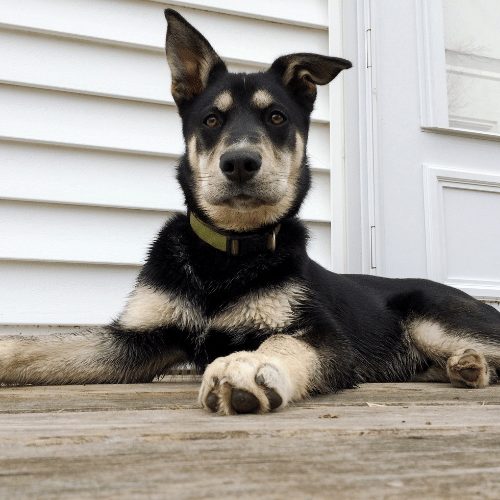
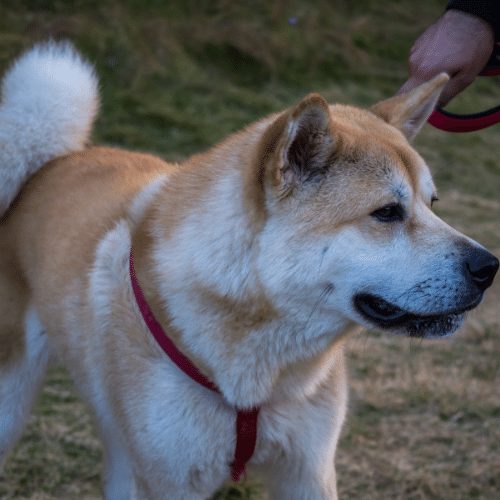
Japanese Akita Inu
The Japanese Akita Inu is a descendent of dogs that were once used for a variety of functions since its origin in the 1600s. From hunting bears over guarding homes to even participating in dog fights, this kind of Husky was a popular dog throughout centuries.
Today the Japanese Akita Inu is less common. They are very tall dogs, standing at 24-28 inches tall and weighing 75-120 pounds. Unless you have a large property and experience in working with independent Northern breeds, this is not the right breed for you.
American Akita
The American Akita is more prevalent in North America today. These dogs are a bit smaller than their Japanese counterparts, with 23-27 inches in height and a weight of 50-90 pounds.
The American Kennel Club currently recognizes the American and Japanese Akita to be two strains of the same breed. However, a lot of breeders are pushing for them to be separated into two distinct breeds.
American Akitas can be quite dominant dogs that have a tendency to get into fights with other dogs.
They are difficult to train, especially for first-time dog owners. American Akita are popular guard dogs that will certainly keep your property safe.
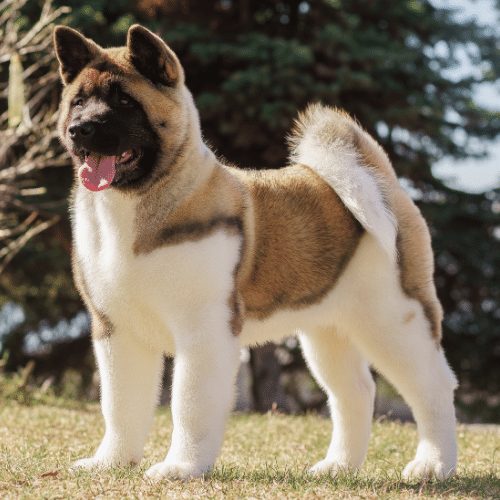
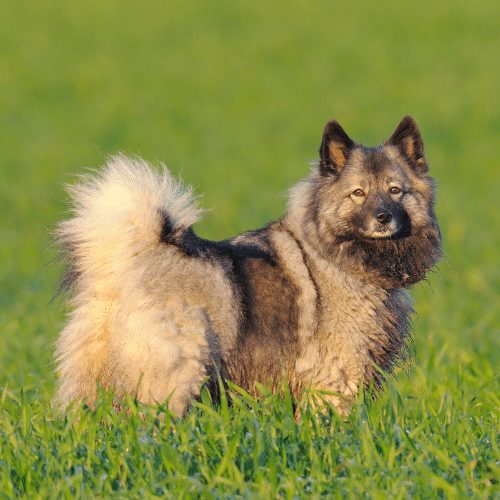
Keeshond
The Keeshond is related to the Samoyed – both are of the Spitz-type. The breed is especially popular in its origin country of Holland.
Contrary to many other original Northern breeds, the Keeshond is highly trainable. These dogs love to please their owners and excel in a variety of sports, such as competition obedience or agility.
Keeshonden (this is the correct plural in Dutch) are medium sized dogs: with 17-18 inches in height and a weight around 35 pounds, they are among the smaller types of Husky.
A Keeshond becomes very attached to his owner and does not do well if left alone for long periods of time. If you spend a lot of time away from home, this is not the right dog for you.
Norwegian Elkhound
This breed originated – of course – in Norway, where it was used to help with hunting moose. In addition, these hardy and brave dogs would guard properties, defend their owners and herd livestock.
Nowadays, Norwegian Elkounds are popular family and companion dogs. Their ability to hunt big game does not mean they are unfriendly dogs – quite the contrary. They get along very well with other dogs and their owners and require less exercise than other Northern breeds such as the Husky.
(Though every dog needs daily exercise and enrichment!)
Eklhounds are very independent thinkers and might challenge owners who have not worked with an original breed before. With their loud bark they are excellent watch dogs.

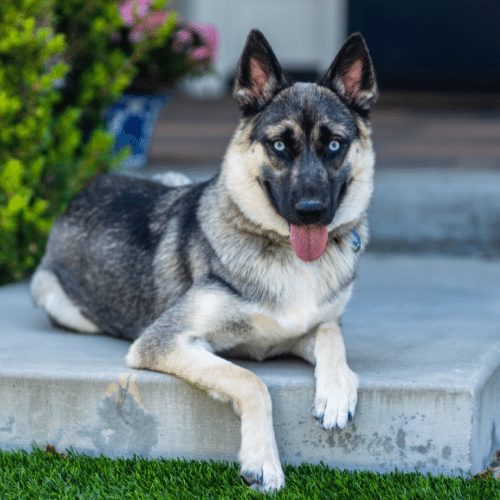
Shepsky
A cross between the Siberian Husky and the German Shepherd, the Shepsky is a shepherd cross breed that, while not recognized by the American Kennel Club (AKC), is endorsed by the American Canine Hybrid Club.
Standing around 20” to 24” tall at the shoulder, the Shepsky is roughly the same size as the Siberian Husky but may appear bigger if they’ve inherited the more sturdy build of the German Shepherd.
Also known as the Gerberian Shepsky, these dogs vary more than most crossbreeds, especially when it comes to temperament. Some may display the intelligence and loyalty of the German Shepherd while others may resemble their Husky parent more, with its affectionate yet independent behavior.
Whatever personality traits your Shepsky has, one thing is undeniable – there will be a lot of shedding and a lot of hair in your home. These dogs “seem to take pride in leaving a layer of fur on everything they touch,” so aren’t ideal for those with allergies or an aversion to housework.
While loyal and intelligent, Shepskys are athletic animals that need plenty of exercise and mental stimulation. Without that, they may become destructive, causing significant damage to furniture, shoes, and pretty much anything else they can get their teeth into.
Although not ideal for a first-time owner, a Shepsky can fit easily into family life, especially a large one with the manpower to deal with their high-energy shenanigans.
MacKenzie River Husky
The confusing origins of the MacKenzie River Husky have produced conflicting opinions about whether it’s a type or a breed. While not currently recognized by the AKC, the MacKenzie is distinct from the Siberian Husky in both build and coat.
It’s believed the MacKenzie River Husky is a type of freight husky that emerged below the arctic circle approximately 100 years ago. Freight huskies worked in small groups, hauling heavy loads across treacherous terrain and through deep snow while relying on meager food sources.
Like the original, albeit extinct, freight husky, the true MacKenzie River Husky is bigger than its Siberian cousin, standing 27” to 32” at the shoulder and weighing as much as 90 lb. They resemble the wolf in many respects – their gait and build are similar, as is their approach to social bonding.
One of the most influential modern-day breeders of the MacKenzie River Husky, Donna Dowling, believes the breed may be related to the long-haired merqujog dog bred by the Central Inuit. The MacKenzie also has a long distinctive coat that is soft to the touch and often features a mane around the dog’s neck and shoulders as well as feathers down their legs.
Although trustworthy and eager to work, the MacKenzie River Husky’s independent and sometimes dominant spirit makes it unsuitable for first-time owners.
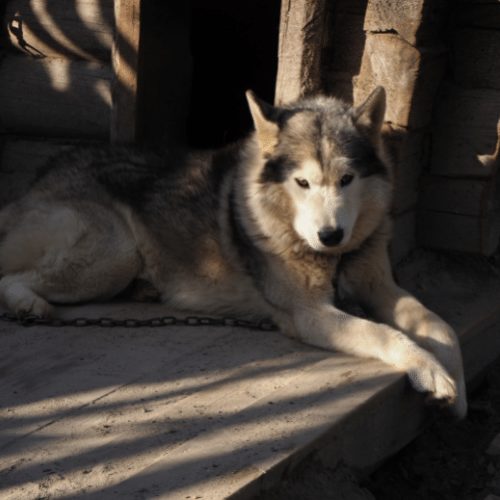

Canadian Eskimo Dog
The Canadian Eskimo Dog, also known as Qimmiq or Exquimaux Husky, is a medium-sized, working breed of dog descended from the dogs used by the Thule people some 1,000 to 4,000 years ago.
The Canadian Eskimo Dog was used to hunt polar bears and pull sleds weighing up to 176 lb. The introduction of snowmobiles had a dramatic impact on the breed and, combined with a government project that saw tens of thousands of dogs slaughtered for health and safety reasons, by the early Seventies, it was nearly extinct.
A revitalization project saved the breed from extinction, and the Canadian Kennel Club (CKC) now has around 300 Canadian Eskimo Dogs on its books.
With the characteristic appearance of the Spitz, the Exquimaux Husky has a powerful build and imposing appearance. The males stand between 22” to 28” tall at the shoulders and weigh up to 88 lb, whereas the females are much smaller, reaching just 66 lb and 24” in height.
Although the CKC recognizes the breed, it also notes that “this is a primitive working breed that cannot be thought of as a domestic pet.” Nevertheless, the Qimmiq is friendly and affectionate, making it a great companion animal for experienced owners. Unsuited for apartment living, these dogs need a lot of exercise and mental stimulation to prevent them from becoming bored or destructive.
Utonagan
Like most Huskies, the Utonagan looks a lot like a wolf, with its long, dense coat so, it should come as no surprise that it was designed with that very goal in mind. Even the name is derived from the Chinook Indian word for ‘spirit of the wolf.’
A mix of Alaskan Malamute, German Shepherd, and Siberian Husky, the Utonagan is a young breed that emerged in the 1980s. It’s believed that the creator of the breed Edwina Harrison, bred the Utonagan in the hopes of producing a dog that would resemble a wolf, but that would be both easy to train and good with families.
The Utonagan has, in many ways, and, unlike most Huskies, has a well-balanced, gentle nature that enables it to adapt well to family life and thrive in the home environment. They are, nevertheless, active dogs that need plenty of exercise and display that independent streak that’s so typical of Huskies.
Although it was never bred to pull sleds or hunt, the Utonagan excels at physically and mentally demanding tasks and has the same boundless energy as its predecessors. Standing up to 30” at the shoulder and weighing as much as 110 lbs, the Utonagan towers over the Alaskan Malamute, but is laidback and affectionate with its owners.

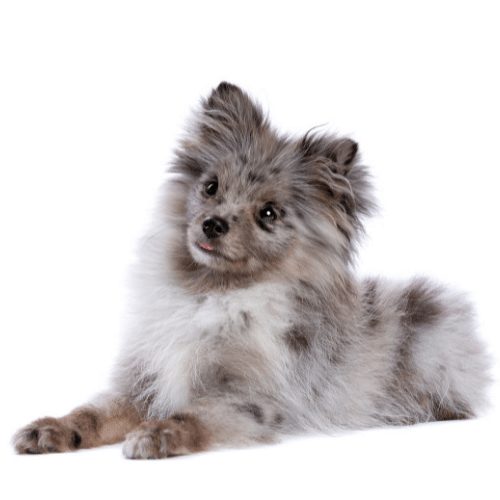
Pomeranian Husky
At the other end of the scale to the hefty Utonagan is one of the smallest types of Husky – the Pomeranian. As its name suggests, this 18” ball of fluff is a cross between the Siberian Husky and the Pomeranian (or an even smaller Teacup Pomeranian).
Also known as the Pomsky, this tiny Husky demonstrates many of the personality traits of its larger cousins and is a playful, intelligent dog with an independent streak that can lead to stubbornness. Early socialization can curb this tendency and also help tame their high prey drive and associated natural aggression.
Despite being strong-willed, Pomeranian Huskies are, in general, friendly and affectionate, which can make them excellent family pets in homes where they receive lots of attention and exercise.
With their long, dense coats, Pomeranian Huskies are year-round shedders that require lots of brushing. They are, however, entertaining dogs that will quickly win you round with their amusing antics.
The Pomerania Husky is one of the newest types of Husky, having emerged in 2009. The first litter of Pomskies was only born in 2012 but, by 2017, they were considered the most popular designer dog in the world. Some of the most sought-after dogs in this breed are merle colored.
Hug Dog
A little larger than the Pomeranian Husky, the Hug is a mix between a Siberian Husky and a Pug. The result is an affectionate and intelligent small breed of dog that stands between 16” and 22” tall and weighs around 45 lb.
Like the Pomsky, a Hug adapts well to both family life and apartment living, although he will also need exercising daily. Although sharing the Siberian Husky’s stubborn streak, the Hug is intelligent and quick to learn.
Hugs tend to vary a lot in appearance with some featuring the short muzzle and flattened face of the Pug and others the blue eyes and erect ears of the Husky. Regardless of their appearance, Hugs are generally friendly, non-aggressive dogs that are eager to please and demand attention.
Some more Pug-like Hugs are quite content to spend their days dozing on the sofa and you may even have to entice your Hug into a game using special treats or toys. Others, however, show more Husky-like tendencies, so are highly active and require lots of physical exercise.
Although the Hug may be easier to handle than other Husky types, it still needs early puppy training to keep unwanted and destructive behavior at bay.
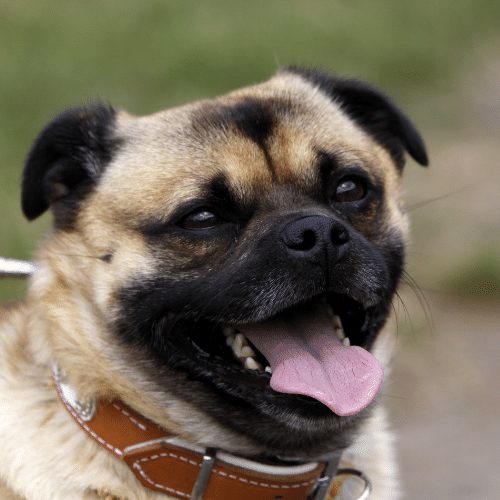
What is the rarest breed of Husky?
The rarest breed of Husky is the Sakhalin Husky. There are very few dogs of this breed left. While experts are uncertain how many exactly, it is estimated that there currently are less than 50 Sakhalin Huskies on the planet.
Due to the small breeding stock and their limited use as sled dogs these days, it is not expected that the breed will grow considerably in the next decade.
What is the best Husky breed?
Which breed of Husky is the best for you will depend on your lifestyle, training experience and ability to exercise your Husky.
Before deciding on a Husky breed, consider the following questions:
- Have you owned and worked with a Northern breed before?
- Are you ready to deal with intense shedding, especially during the season change?
- What will you use your dog for (sled dog racing, agility, obedience, running – or as a companion dog)?
- Do you have a large, fenced-in property?
- Do you need your dog to be social with people and other animals?
- Do you have cats or very small dogs?
If you are looking for a strong guard dog, an Akita would be a great choice.
If you are a first-time dog owner, you should pick an easy-to-train type of Husky, such as an American Eskimo or Keeshond.
Are you planning on competing in sled dog races or taking your dog on very long runs? Then an Alaskan Husky or Siberian Husky is the right kind of Husky for you.
As with picking any dog breed, consider if you can make the commitment to caring for and fulfilling your dog’s needs throughout his life!

